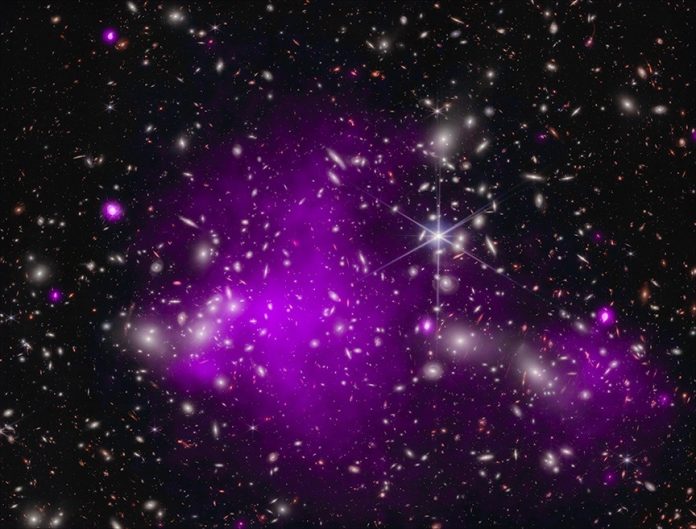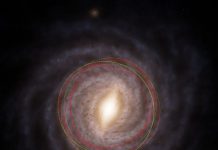
One of the big questions in cosmology asks when black holes first showed up in the early Universe.
Recently astronomers discovered the most distant (and therefore earliest) supermassive black hole ever seen.
It appears as it did when the Universe was only 470 million years old.
This monster black hole is really bright in X-rays, which made it a great target for the Chandra X-ray Observatory. It’s also just bright enough in infrared light for the James Webb Space Telescope to see.
“We needed Webb to find this remarkably distant galaxy and Chandra to find its supermassive black hole,” said Akos Bogdan of the Center for Astrophysics at Harvard. Bogdan and his team just published a paper about the observations.
“We also took advantage of a cosmic magnifying glass that boosted the amount of light we detected.”
Essentially astronomers got their data through a gravitational lens, then combined data from both orbiting telescopes to create a unique look at the black hole.
The black hole is the heart of a quasar—an active galaxy called UHZ1. Its light is magnified by passing through the nearby galaxy cluster Abell 2744.
That light left the quasar when the Universe was only 3 percent of its current age.
Webb spotted it thanks to faint infrared signals from the activity surrounding the black hole.
Chandra observed it for two weeks and found a huge amount of X-ray emissions from superheated gas in the galaxy. This indicated to them that the black hole is rapidly eating up material around it.
Quasars With Black Holes in the Infant Universe
Quasars in the early Universe tell us a lot about conditions in the time after the Big Bang. In particular, they open a window on black hole formation.
It’s not completely clear how some supermassive black holes grew to be so massive so quickly after the Big Bang. First, you have to understand how they formed.
Were they born from the collapse of massive gas clouds to create black holes ranging up to 100,000 solar masses?
Or, were the explosions of the first supermassive stars the culprit? If So, the mass of those black holes would have been only 10 to 100 solar masses. Understanding the formation scenario helps astronomers understand the conditions at the time.
“There are physical limits on how quickly black holes can grow once they’ve formed, but ones that are born more massive have a head start. It’s like planting a sapling, which takes less time to grow into a full-size tree than if you started with only a seed”, said paper co-author Andy Goulding of Princeton University.
A good formation scenario
For this particular black hole, the first scenario seems to explain how it formed. You can tell by its mass—10 million to 100 million solar masses—that the infall of a massive gas cloud that created it.
The brightness and intensity of the X-rays Chandra detected tell the tale. Also, the mass of the black hole is about equal to the mass of all the stars in its host galaxy. The authors of the paper refer to it as an “Outsize Black Hole.”
“We think that this is the first detection of an ‘Outsize Black Hole’ and the best evidence yet obtained that some black holes form from massive clouds of gas,” said Piyamvada Natarajan of Yale University, whose 2017 work predicted such an object.
“For the first time, we are seeing a brief stage where a supermassive black hole weighs about as much as the stars in its galaxy before it falls behind.”
Black Holes at Early Epochs
In their paper, the authors of this discovery point out that quasars with supermassive black holes like the one in UHZ1 were in place well before 700 million years after the Big Bang.
So, they existed, but their origins remain something of a mystery.
Searching out the “seeds” of these objects requires looking at many of these galaxies across huge distances. By the time their light reaches us, it’s highly redshifted.
That’s why Webb is required to detect many of these galaxies. Once that’s done, figuring out the X-ray emissions helps tell the rest of the tale.
Of course, the authors had to differentiate between active star-forming regions and black hole formation in these distant galaxies. They also had to make sure it wasn’t coming from any intracluster gas regions in the intervening Abell 2744 cluster.
What’s left after all the analysis is a conclusion that these early massive black holes were born when the massive “seeds” (clouds of gas) coalesced in a very short period of time after the Big Bang.
As the JWST finds more early galaxies in the infant Universe, more of these “Outsize Black Holes” will certainly show up.
Their existence and the conditions around them should help solidify the theory behind the black hole “seeds” in early gas clouds.
Follow us on Twitter for more articles about this topic.
Written by Carolyn Collins Petersen/Universe Today.



